Unit 9 I like music that I can dance to.导学案(共5课时) 2024-2025学年人教版英语九年级全册
文档属性
| 名称 | Unit 9 I like music that I can dance to.导学案(共5课时) 2024-2025学年人教版英语九年级全册 | 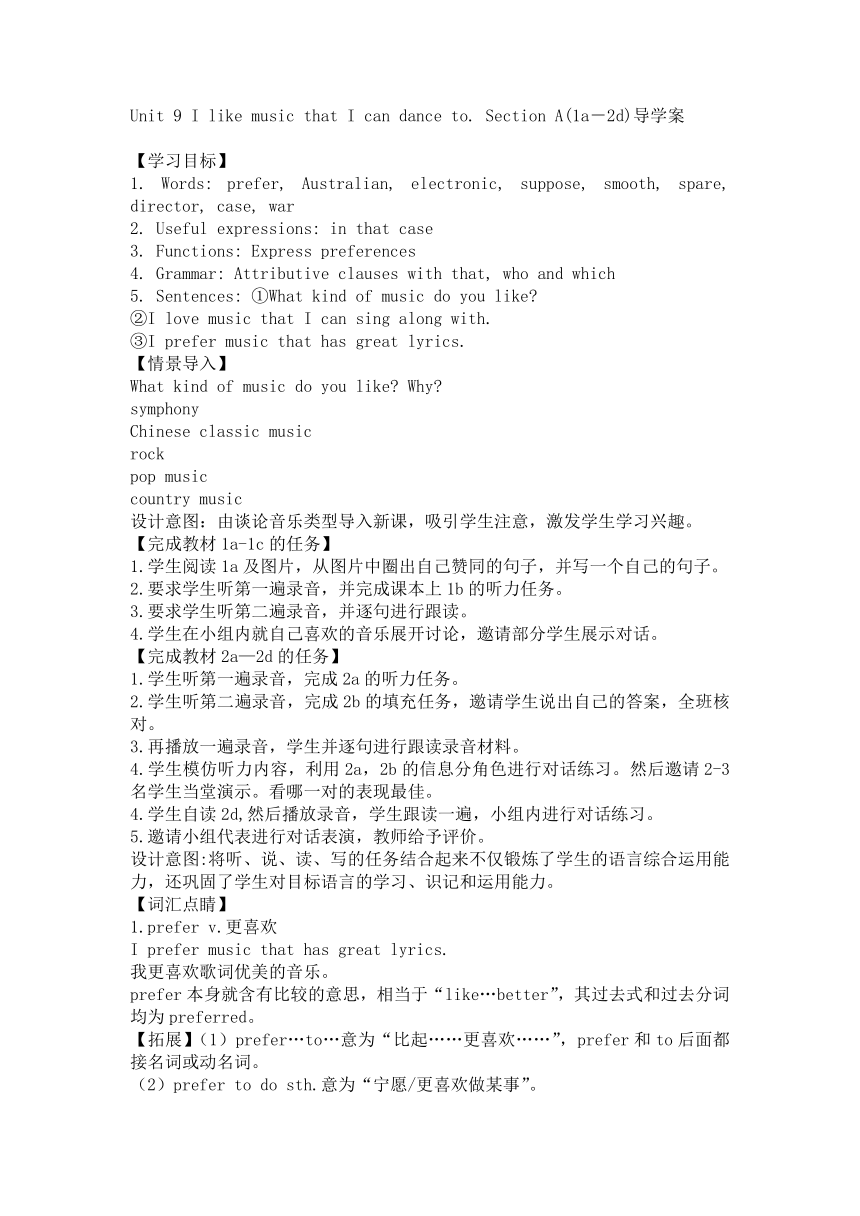 | |
| 格式 | docx | ||
| 文件大小 | 32.4KB | ||
| 资源类型 | 教案 | ||
| 版本资源 | 人教新目标(Go for it)版 | ||
| 科目 | 英语 | ||
| 更新时间 | 2024-06-26 09:58:15 | ||
图片预览

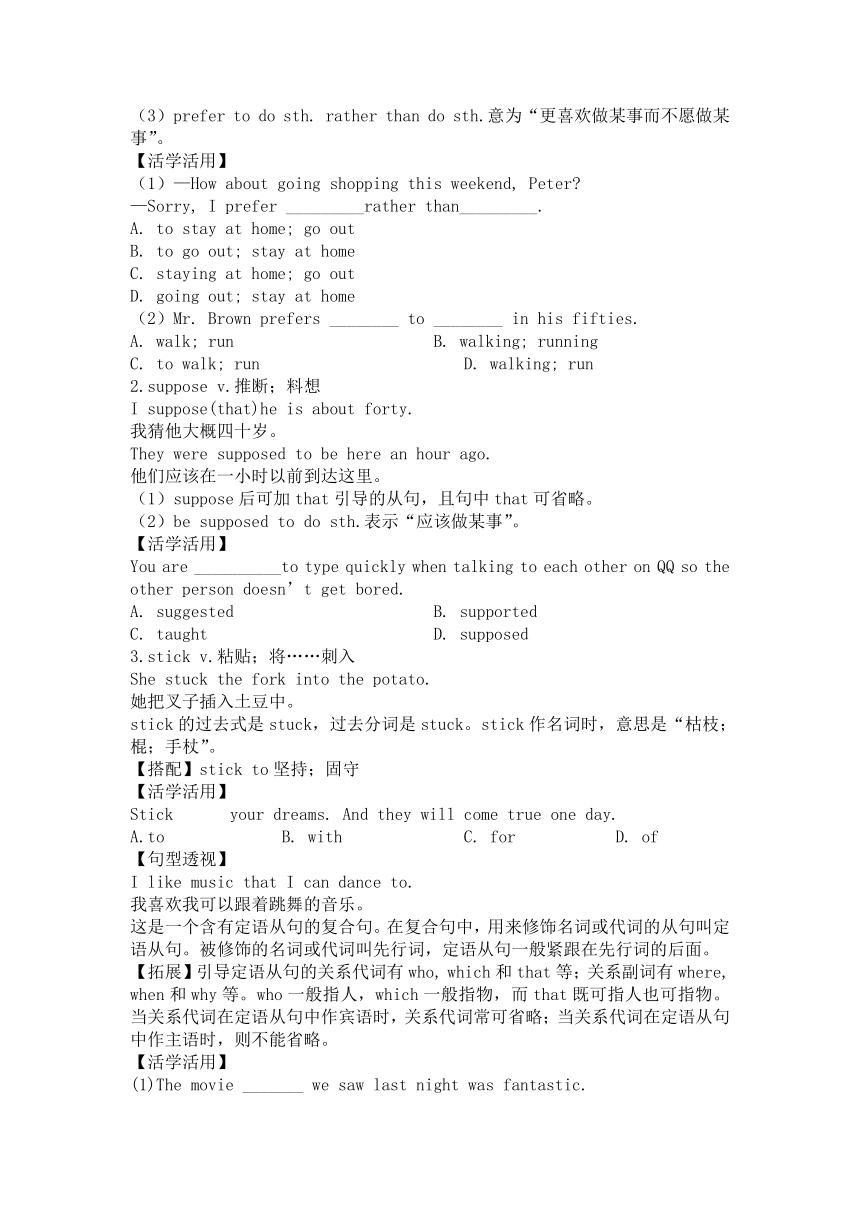
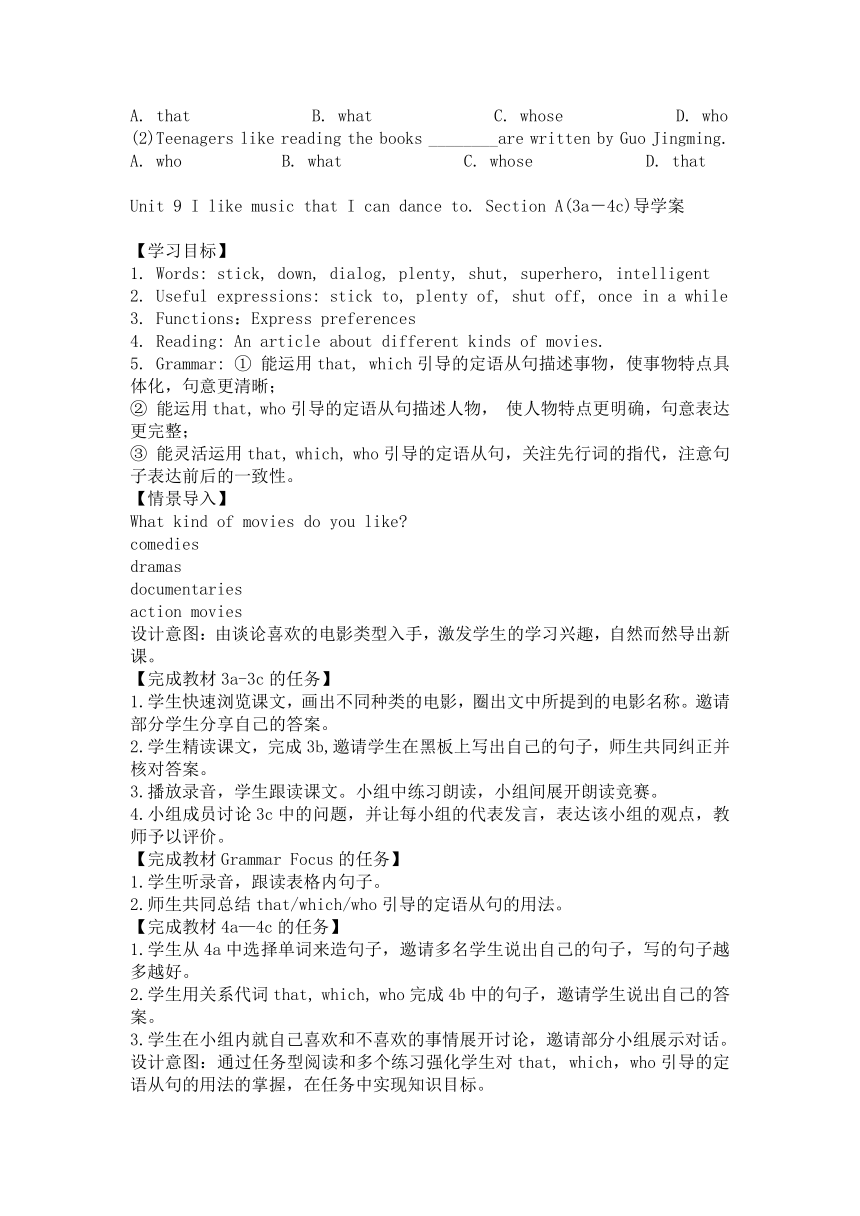
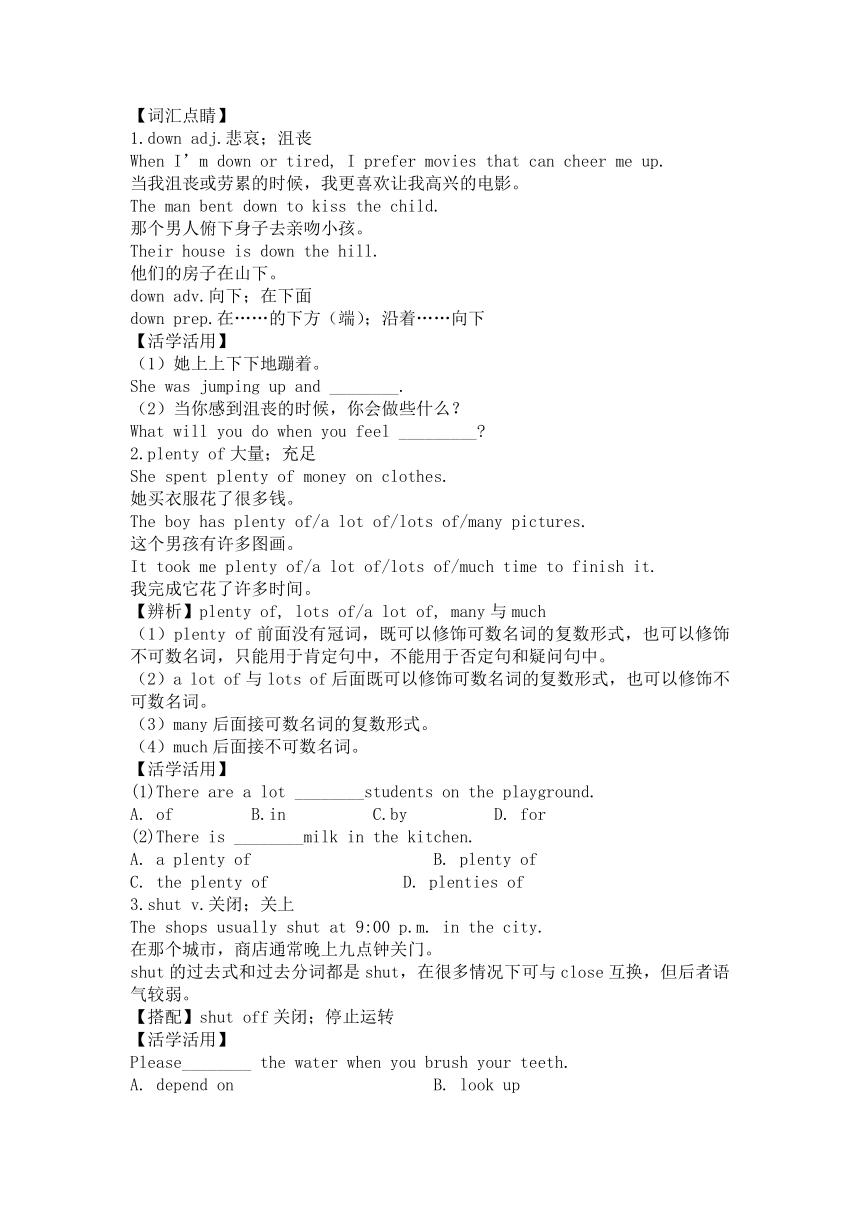
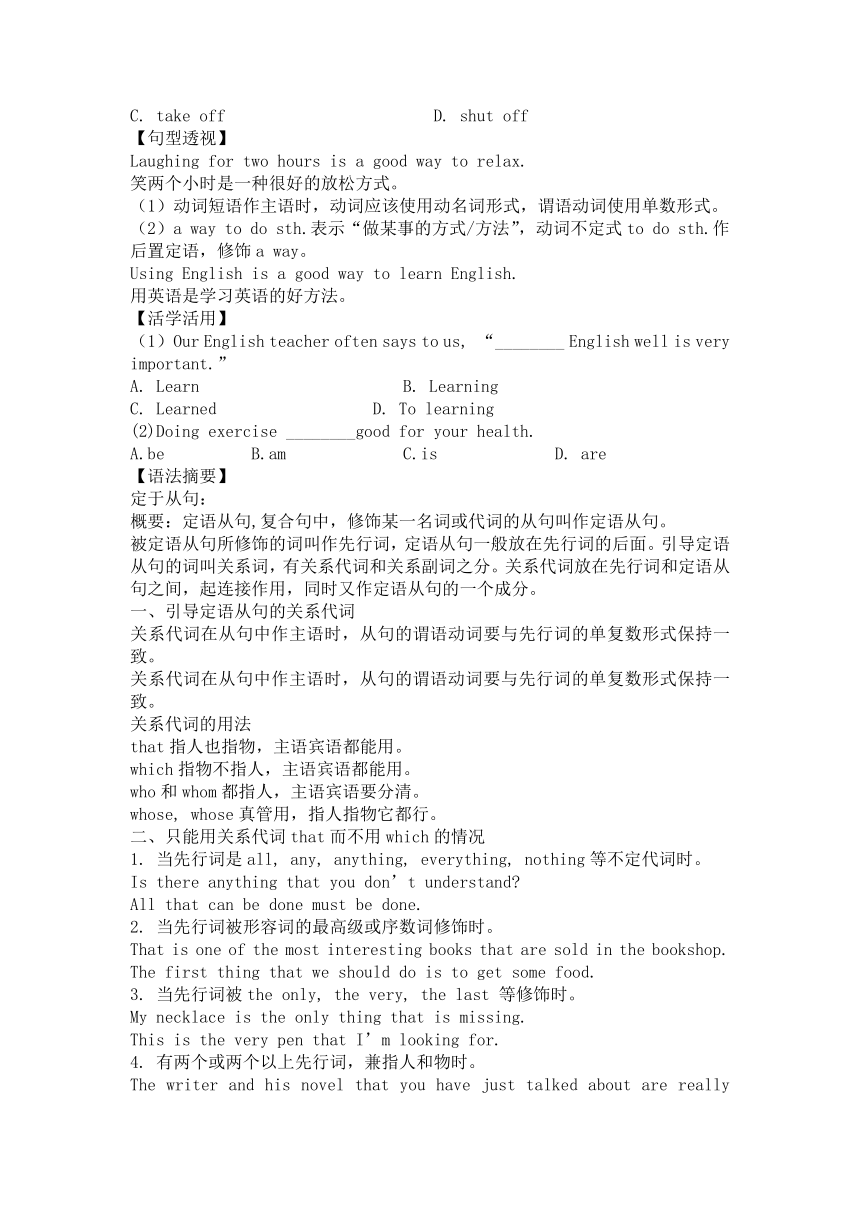
文档简介
Unit 9 I like music that I can dance to. Section A(1a-2d)导学案
【学习目标】
1. Words: prefer, Australian, electronic, suppose, smooth, spare, director, case, war
2. Useful expressions: in that case
3. Functions: Express preferences
4. Grammar: Attributive clauses with that, who and which
5. Sentences: ①What kind of music do you like
②I love music that I can sing along with.
③I prefer music that has great lyrics.
【情景导入】
What kind of music do you like Why
symphony
Chinese classic music
rock
pop music
country music
设计意图:由谈论音乐类型导入新课,吸引学生注意,激发学生学习兴趣。
【完成教材1a-1c的任务】
1.学生阅读1a及图片,从图片中圈出自己赞同的句子,并写一个自己的句子。
2.要求学生听第一遍录音,并完成课本上1b的听力任务。
3.要求学生听第二遍录音,并逐句进行跟读。
4.学生在小组内就自己喜欢的音乐展开讨论,邀请部分学生展示对话。
【完成教材2a—2d的任务】
1.学生听第一遍录音,完成2a的听力任务。
2.学生听第二遍录音,完成2b的填充任务,邀请学生说出自己的答案,全班核对。
3.再播放一遍录音,学生并逐句进行跟读录音材料。
4.学生模仿听力内容,利用2a,2b的信息分角色进行对话练习。然后邀请2-3名学生当堂演示。看哪一对的表现最佳。
4.学生自读2d,然后播放录音,学生跟读一遍,小组内进行对话练习。
5.邀请小组代表进行对话表演,教师给予评价。
设计意图:将听、说、读、写的任务结合起来不仅锻炼了学生的语言综合运用能力,还巩固了学生对目标语言的学习、识记和运用能力。
【词汇点睛】
1.prefer v.更喜欢
I prefer music that has great lyrics.
我更喜欢歌词优美的音乐。
prefer本身就含有比较的意思,相当于“like…better”,其过去式和过去分词均为preferred。
【拓展】(1)prefer…to…意为“比起……更喜欢……”,prefer和to后面都接名词或动名词。
(2)prefer to do sth.意为“宁愿/更喜欢做某事”。
(3)prefer to do sth. rather than do sth.意为“更喜欢做某事而不愿做某事”。
【活学活用】
(1)—How about going shopping this weekend, Peter
—Sorry, I prefer _________rather than_________.
A. to stay at home; go out
B. to go out; stay at home
C. staying at home; go out
D. going out; stay at home
(2)Mr. Brown prefers ________ to ________ in his fifties.
A. walk; run B. walking; running
C. to walk; run D. walking; run
2.suppose v.推断;料想
I suppose(that)he is about forty.
我猜他大概四十岁。
They were supposed to be here an hour ago.
他们应该在一小时以前到达这里。
(1)suppose后可加that引导的从句,且句中that可省略。
(2)be supposed to do sth.表示“应该做某事”。
【活学活用】
You are __________to type quickly when talking to each other on QQ so the other person doesn’t get bored.
A. suggested B. supported
C. taught D. supposed
3.stick v.粘贴;将……刺入
She stuck the fork into the potato.
她把叉子插入土豆中。
stick的过去式是stuck,过去分词是stuck。stick作名词时,意思是“枯枝;棍;手杖”。
【搭配】stick to坚持;固守
【活学活用】
Stick your dreams. And they will come true one day.
A.to B. with C. for D. of
【句型透视】
I like music that I can dance to.
我喜欢我可以跟着跳舞的音乐。
这是一个含有定语从句的复合句。在复合句中,用来修饰名词或代词的从句叫定语从句。被修饰的名词或代词叫先行词,定语从句一般紧跟在先行词的后面。
【拓展】引导定语从句的关系代词有who, which和that等;关系副词有where, when和why等。who一般指人,which一般指物,而that既可指人也可指物。当关系代词在定语从句中作宾语时,关系代词常可省略;当关系代词在定语从句中作主语时,则不能省略。
【活学活用】
(1)The movie _______ we saw last night was fantastic.
A. that B. what C. whose D. who
(2)Teenagers like reading the books ________are written by Guo Jingming.
A. who B. what C. whose D. that
Unit 9 I like music that I can dance to. Section A(3a-4c)导学案
【学习目标】
1. Words: stick, down, dialog, plenty, shut, superhero, intelligent
2. Useful expressions: stick to, plenty of, shut off, once in a while
3. Functions:Express preferences
4. Reading: An article about different kinds of movies.
5. Grammar: ① 能运用that, which引导的定语从句描述事物,使事物特点具体化,句意更清晰;
② 能运用that, who引导的定语从句描述人物, 使人物特点更明确,句意表达更完整;
③ 能灵活运用that, which, who引导的定语从句,关注先行词的指代,注意句子表达前后的一致性。
【情景导入】
What kind of movies do you like
comedies
dramas
documentaries
action movies
设计意图:由谈论喜欢的电影类型入手,激发学生的学习兴趣,自然而然导出新课。
【完成教材3a-3c的任务】
1.学生快速浏览课文,画出不同种类的电影,圈出文中所提到的电影名称。邀请部分学生分享自己的答案。
2.学生精读课文,完成3b,邀请学生在黑板上写出自己的句子,师生共同纠正并核对答案。
3.播放录音,学生跟读课文。小组中练习朗读,小组间展开朗读竞赛。
4.小组成员讨论3c中的问题,并让每小组的代表发言,表达该小组的观点,教师予以评价。
【完成教材Grammar Focus的任务】
1.学生听录音,跟读表格内句子。
2.师生共同总结that/which/who引导的定语从句的用法。
【完成教材4a—4c的任务】
1.学生从4a中选择单词来造句子,邀请多名学生说出自己的句子,写的句子越多越好。
2.学生用关系代词that, which, who完成4b中的句子,邀请学生说出自己的答案。
3.学生在小组内就自己喜欢和不喜欢的事情展开讨论,邀请部分小组展示对话。
设计意图:通过任务型阅读和多个练习强化学生对that, which,who引导的定语从句的用法的掌握,在任务中实现知识目标。
【词汇点睛】
1.down adj.悲哀;沮丧
When I’m down or tired, I prefer movies that can cheer me up.
当我沮丧或劳累的时候,我更喜欢让我高兴的电影。
The man bent down to kiss the child.
那个男人俯下身子去亲吻小孩。
Their house is down the hill.
他们的房子在山下。
down adv.向下;在下面
down prep.在……的下方(端);沿着……向下
【活学活用】
(1)她上上下下地蹦着。
She was jumping up and ________.
(2)当你感到沮丧的时候,你会做些什么?
What will you do when you feel _________
2.plenty of大量;充足
She spent plenty of money on clothes.
她买衣服花了很多钱。
The boy has plenty of/a lot of/lots of/many pictures.
这个男孩有许多图画。
It took me plenty of/a lot of/lots of/much time to finish it.
我完成它花了许多时间。
【辨析】plenty of, lots of/a lot of, many与much
(1)plenty of前面没有冠词,既可以修饰可数名词的复数形式,也可以修饰不可数名词,只能用于肯定句中,不能用于否定句和疑问句中。
(2)a lot of与lots of后面既可以修饰可数名词的复数形式,也可以修饰不可数名词。
(3)many后面接可数名词的复数形式。
(4)much后面接不可数名词。
【活学活用】
(1)There are a lot ________students on the playground.
A. of B.in C.by D. for
(2)There is ________milk in the kitchen.
A. a plenty of B. plenty of
C. the plenty of D. plenties of
3.shut v.关闭;关上
The shops usually shut at 9:00 p.m. in the city.
在那个城市,商店通常晚上九点钟关门。
shut的过去式和过去分词都是shut,在很多情况下可与close互换,但后者语气较弱。
【搭配】shut off关闭;停止运转
【活学活用】
Please________ the water when you brush your teeth.
A. depend on B. look up
C. take off D. shut off
【句型透视】
Laughing for two hours is a good way to relax.
笑两个小时是一种很好的放松方式。
(1)动词短语作主语时,动词应该使用动名词形式,谓语动词使用单数形式。
(2)a way to do sth.表示“做某事的方式/方法”,动词不定式to do sth.作后置定语,修饰a way。
Using English is a good way to learn English.
用英语是学习英语的好方法。
【活学活用】
(1)Our English teacher often says to us, “________ English well is very important.”
A. Learn B. Learning
C. Learned D. To learning
(2)Doing exercise ________good for your health.
A.be B.am C.is D. are
【语法摘要】
定于从句:
概要:定语从句,复合句中,修饰某一名词或代词的从句叫作定语从句。
被定语从句所修饰的词叫作先行词,定语从句一般放在先行词的后面。引导定语从句的词叫关系词,有关系代词和关系副词之分。关系代词放在先行词和定语从句之间,起连接作用,同时又作定语从句的一个成分。
一、引导定语从句的关系代词
关系代词在从句中作主语时,从句的谓语动词要与先行词的单复数形式保持一致。
关系代词在从句中作主语时,从句的谓语动词要与先行词的单复数形式保持一致。
关系代词的用法
that指人也指物,主语宾语都能用。
which指物不指人,主语宾语都能用。
who和whom都指人,主语宾语要分清。
whose, whose真管用,指人指物它都行。
二、只能用关系代词that而不用which的情况
1. 当先行词是all, any, anything, everything, nothing等不定代词时。
Is there anything that you don’t understand
All that can be done must be done.
2. 当先行词被形容词的最高级或序数词修饰时。
That is one of the most interesting books that are sold in the bookshop.
The first thing that we should do is to get some food.
3. 当先行词被the only, the very, the last 等修饰时。
My necklace is the only thing that is missing.
This is the very pen that I’m looking for.
4. 有两个或两个以上先行词,兼指人和物时。
The writer and his novel that you have just talked about are really well-known.
三、只能用关系代词which而不用that的情况
1. 引导非限制性定语从句(主句和从句之间用逗号隔开)时。
The tree, which is four hundred years old, is very famous here.
2. 先行词指物,且关系代词前面有介词时。
This is the city in which Tom lives.
3. 先行词为that或those时。
What is that which he bought yesterday
四、引导定语从句的关系副词
关系副词所代替的先行词是表示时间、地点或原因的名词,在句中作状语。
It happened in November when the weather was wet and cold.
This is the room where I lived last year.
We don’t know the reason why he was late for school.
如果表示时间或地点的名词在从句中作主语或宾语,关系词要用that/which。
I won’t forget the time that/which we spent in the countryside.
Unit 9 I like music that I can dance to. Section B(1a-1d)导学案
【学习目标】
1. Functions: To give students listening and speaking practice.
2. Sentences: ① He likes clothes that are unusual.
② I like movies that are scary.
【情景导入】
Which band do you like best
What kind of book do you like best
What kind of movie do you like best
设计意图:电影,书籍和乐队都是学生感兴趣的话题,由此入题,迅速激起学生的讨论热情。
【完成教材1a-1d的任务】
1.学生阅读1a,在表格中填入自己最喜爱的书,电影和乐队。
Movie……Book……Band……
2.学生听第一遍录音,完成教材1b任务,核对答案。
3.学生听第二遍录音,完成教材1c任务,核对答案。
4.学生在小组中展开讨论,谈论自己喜欢的食物(书﹑电影﹑乐队),并说说自己喜欢的原因。邀请部分学生展示对话,教师给予评价。
设计意图:学生在听,说,读,写中巩固了对目标语言的学习,识记和运用。
Unit 9 I like music that I can dance to. Section B(2a-2e)
导学案
【学习目标】
1. Words: sense, sadness, pain, reflect, perform, pity, total, master, praise, wound, painful
2. Useful expressions: in total
3. Reading strategies: noting supporting details, skimming and scanning
【情景导入】
Do you know these instruments
Do you know any famous music that played by these instruments
设计意图:通过了解中国古代的乐器,欣赏由其中一些乐器演奏的音乐,自然导入新课内容。
【完成教材 2b—2e的任务】
1.学生快速默读短文,熟知大意,并完成课本2b中的任务。然后邀请几位学生给出自己的答案,全班一起检查讨论。
2.先邀请几位学生阅读短文(可一人一段),教师要注意语音,及时纠正。然后播放录音,全班同学一起跟读。
3.完成教材2c的任务,要求学生将答案书写在黑板上,并当堂修订。
4.完成教材2d中的任务,并邀请2-3对学生给出答案。
5.小组内讨论2e中的问题,并邀请部分学生发表自己的观点。
【词汇点睛】
1.pain n.痛苦;疼痛;苦恼
The boy cried with pain.
这个男孩痛得哭了起来。
The death of his father gave him much pain.
他父亲的去世使他很悲痛。
The ache in his back lasted for two days.
他的背痛了两天。
【辨析】pain与ache
(1)pain的应用范围较广,可指轻微的痛或剧烈的痛、局部的痛或全身的痛、持续的痛或突发性的痛等,也可以用于引申义,表示精神或感情上的痛苦。
(2)ache主要指肉体局部持续的疼痛或隐痛。
【活学活用】
根据汉语完成句子。
(1)他的话让她很痛苦。
His words caused her much _______.
(2)我的牙痛了一星期了。
The ________ in my tooth lasted for a week.
2.look up(在词典、参考书中或通过电脑)查阅;抬头看
I don’t know the new word. Let’s look it up in the dictionary.
我不认识这个新单词,咱们查一下词典吧。
look up是“动词+副词”短语,代词若作其宾语,需要放在look和up之间。
【拓展】
look out小心;注意
look through浏览
look like看起来像
look for寻找
look at看
look after照顾
【活学活用】
(1)Linda, I have to go shopping now. Please ________ your little sister at home.
A. look for B. look like
C. look after D. look up
(2)This morning I ________ some new restaurants on the Internet for I wanted to take Mia to a nice restaurant for her birthday.
A. picked up B. looked up
C. cleaned up D. gave up
3.perform v.表演;执行
One should always perform what one promises.
一个人应该说到做到。
She will be performing at the piano.
她将演奏钢琴。
【拓展】performer n.演奏者
performance n.演出
【活学活用】
用perform的适当形式填空。
(1)The singer had never _________ in Beijing before.
(2)He is a great _________. We like him very much.
(3)Do you like the _________ that we saw last night
4.total n.总数;合计adj.总的;全体的
【搭配】in total总共;合计
【活学活用】
他的计划以彻底失败告终。
His plan ended _________ failure.
5. The music was strangely beautiful, but under the beauty I sensed a strong sadness and pain.
sense v. 感觉到;意识到 n. 感觉;意识
(1) sense在此处作及物动词,意为“感觉到;意识到” 。
We can sense his sadness.
(2) sense还可作可数名词,意为“感觉;意识”。
常构成短语a sense of “......的感觉”。
We all believe in him because he has a strong sense of duty.
6. The music was strangely beautiful, but under the beauty I sensed a strong sadness and pain.
sadness n. 悲伤;悲痛
sadness由“sad ( adj.悲伤的) + -ness (名词后缀)”构成,通常用作不可数名词,但当其前有形容词修饰时,形容词前可加不定冠词,表示“一种……样的悲伤”。有类似用法的词还有education, help, knowledge等。
Friends should share happiness and sadness.
He has a wide knowledge of music.
【拓展延伸】
有些形容词后加-ness,构成名词,表示性质、状态或特点。
ill (adj. 生病的) → illness (n.疾病)
kind (adj. 善良的) → kindness (n.善良)
happy (adj. 幸福的) → happiness (n. 幸福)
7. The piece had a simple name, Erquan Yingyue (Moon Reflected on Second Spring), but it was one of the most moving pieces of music that I’ve ever heard.
reflect v. 反映;映出
reflect作动词,常用于被动语态。其名词形式为reflection,意为“映像;反映”。
Her face was reflected in the mirror.
Can you see your reflection in the glass
Your clothes are often a reflection of your personality.
8. It is a pity that only six pieces of music in total were recorded for the future world to hear, …
pity n. 遗憾;怜悯 v. 同情;怜悯
(1) pity在此处作名词,意为“遗憾”,相当于shame。
It would be a pity to give up now — you’ve nearly finished.
(2) pity作名词,还可意为“怜悯”,此时不等同于shame。
take pity on ... 意为“同情/怜悯......”。
The old lady often takes pity on small animals.
(3) pity还可作动词,意为“同情;怜悯”。
Pity those on the street who are homeless.
9. Today, Abing’s Erquan Yingyue is a piece which all the great erhu masters play and praise.
master n. 大师;能手;主人 v. 掌握
(1) master在此处作可数名词,意为“大师;能手”。此外,master作名词,还有“主人”的意思。
Mei Lanfang is a master of Bejing Opera.
The cat stayed beside its master until the end of his life.
(2) master还可作及物动词,意为“掌握”。
Duff soon mastered the skills of radio production. He was really a master of learning.
10 Today, Abing’s Erquan Yingyue is a piece which all the great erhu masters play and praise.
praise v. & n. 表扬;赞扬
(1) praise在此句中作动词,常用短语:praise sb. /sth. for (doing)sth. 因(做)某事而赞扬某人/某物。
The policeman praised the young man for saving the little girl.
Everyone praises Hangzhou for its scenery.
(2) praise 还可作名词,意为“赞扬;赞美” 。常用短语:in (high ) praise of “(高度)赞美......”; win/ receive praise (from...)“赢得/获得 ( ...... 的)称赞”。
She wrote poems in praise of freedom.
11. Its sad beauty not only paints a picture of Abing’s own life but also makes people recall their deepest wounds from their own sad or painful experiences.
recall v. 回忆起;回想起
recall由“re-(前缀) + call”构成,在此处作及物动词,其后接名词、代词、动词-ing形式或从句等作宾语。
I can’t recall it.
I can’t recall what he said at the meeting.
12. Its sad beauty not only paints a picture of Abing’s own life but also makes people recall their deepest wounds from their own sad or painful experiences.
wound n. 伤;伤口;创伤 v. 使(身体)受伤;伤害
(1) wound在此处作可数名词,意为“伤;伤口;创伤”。多指在战场上所受的刀伤、枪伤等,也可指精神上所受的伤害。
It’s reported that six soldiers died from wounds.
That was a wound to his pride.
(2) wound还可作动词,意为“使(身体)受伤;伤害”。
Two soldiers were wounded in the battle.
【句型透视】
It is a pity that only six pieces of music in total were recorded for the future world to hear, but his popularity continues to this day.
遗憾的是总共仅有六首音乐被记录了下来,为后世所听,但是他的受欢迎程度持续到了今天。
该句的句型是“It+ be+名词+that从句”此类名词有a shame, a fact, an honor, a good thing, good news等。
【活学活用】
我们这周末去看电影是一个好主意。
______________________ we go to a movie this weekend.
Unit 9 I like music that I can dance to. Section B(3a-Self Check)导学案
【学习目标】
1. Functions: Express preferences
2. Writing: Write an article about your favorite kind of music/movie and your favorite song/movie.
【情景导入】
What kind of music/groups do you like/love/prefer
Make a survey. Work in group of four, ask and answer.
What kind of movies/music do you like
How do you feel after watching/listening to them
Can you name one of the movies/songs you like
Who do you usually watch/listen to them with
Fill in the chart with the results of the discussion.
What is the most popular kind of movie/music in your class
设计意图:通过对最喜欢的电影、电视、歌曲的讨论,引入新课内容。
【完成教材3a—3b的任务】
1.小组内讨论3a中的问题,并将讨论的结果汇报给全班同学。
2.根据3b中的提示内容,让2-3名学生到黑板上写作文,然后全班同学帮助其修改。再让写得好的学生向全班朗读自己的作文。
3.指导学生的写作训练和写作技巧。
设计意图:通过课本阅读训练任务,培养学生的阅读能力,并让学生学会自己解决问题,在解决问题的过程中将所学知识得以运用。通过小组讨论和写作训练,培养学生的写作技巧和综合运用语言能力。
【完成教材Self Check 的任务】
1. 完成Self Check 1 的任务。
2. 完成Self Check 2 的任务。
3. 完成Self Check 3 的任务。
【学习目标】
1. Words: prefer, Australian, electronic, suppose, smooth, spare, director, case, war
2. Useful expressions: in that case
3. Functions: Express preferences
4. Grammar: Attributive clauses with that, who and which
5. Sentences: ①What kind of music do you like
②I love music that I can sing along with.
③I prefer music that has great lyrics.
【情景导入】
What kind of music do you like Why
symphony
Chinese classic music
rock
pop music
country music
设计意图:由谈论音乐类型导入新课,吸引学生注意,激发学生学习兴趣。
【完成教材1a-1c的任务】
1.学生阅读1a及图片,从图片中圈出自己赞同的句子,并写一个自己的句子。
2.要求学生听第一遍录音,并完成课本上1b的听力任务。
3.要求学生听第二遍录音,并逐句进行跟读。
4.学生在小组内就自己喜欢的音乐展开讨论,邀请部分学生展示对话。
【完成教材2a—2d的任务】
1.学生听第一遍录音,完成2a的听力任务。
2.学生听第二遍录音,完成2b的填充任务,邀请学生说出自己的答案,全班核对。
3.再播放一遍录音,学生并逐句进行跟读录音材料。
4.学生模仿听力内容,利用2a,2b的信息分角色进行对话练习。然后邀请2-3名学生当堂演示。看哪一对的表现最佳。
4.学生自读2d,然后播放录音,学生跟读一遍,小组内进行对话练习。
5.邀请小组代表进行对话表演,教师给予评价。
设计意图:将听、说、读、写的任务结合起来不仅锻炼了学生的语言综合运用能力,还巩固了学生对目标语言的学习、识记和运用能力。
【词汇点睛】
1.prefer v.更喜欢
I prefer music that has great lyrics.
我更喜欢歌词优美的音乐。
prefer本身就含有比较的意思,相当于“like…better”,其过去式和过去分词均为preferred。
【拓展】(1)prefer…to…意为“比起……更喜欢……”,prefer和to后面都接名词或动名词。
(2)prefer to do sth.意为“宁愿/更喜欢做某事”。
(3)prefer to do sth. rather than do sth.意为“更喜欢做某事而不愿做某事”。
【活学活用】
(1)—How about going shopping this weekend, Peter
—Sorry, I prefer _________rather than_________.
A. to stay at home; go out
B. to go out; stay at home
C. staying at home; go out
D. going out; stay at home
(2)Mr. Brown prefers ________ to ________ in his fifties.
A. walk; run B. walking; running
C. to walk; run D. walking; run
2.suppose v.推断;料想
I suppose(that)he is about forty.
我猜他大概四十岁。
They were supposed to be here an hour ago.
他们应该在一小时以前到达这里。
(1)suppose后可加that引导的从句,且句中that可省略。
(2)be supposed to do sth.表示“应该做某事”。
【活学活用】
You are __________to type quickly when talking to each other on QQ so the other person doesn’t get bored.
A. suggested B. supported
C. taught D. supposed
3.stick v.粘贴;将……刺入
She stuck the fork into the potato.
她把叉子插入土豆中。
stick的过去式是stuck,过去分词是stuck。stick作名词时,意思是“枯枝;棍;手杖”。
【搭配】stick to坚持;固守
【活学活用】
Stick your dreams. And they will come true one day.
A.to B. with C. for D. of
【句型透视】
I like music that I can dance to.
我喜欢我可以跟着跳舞的音乐。
这是一个含有定语从句的复合句。在复合句中,用来修饰名词或代词的从句叫定语从句。被修饰的名词或代词叫先行词,定语从句一般紧跟在先行词的后面。
【拓展】引导定语从句的关系代词有who, which和that等;关系副词有where, when和why等。who一般指人,which一般指物,而that既可指人也可指物。当关系代词在定语从句中作宾语时,关系代词常可省略;当关系代词在定语从句中作主语时,则不能省略。
【活学活用】
(1)The movie _______ we saw last night was fantastic.
A. that B. what C. whose D. who
(2)Teenagers like reading the books ________are written by Guo Jingming.
A. who B. what C. whose D. that
Unit 9 I like music that I can dance to. Section A(3a-4c)导学案
【学习目标】
1. Words: stick, down, dialog, plenty, shut, superhero, intelligent
2. Useful expressions: stick to, plenty of, shut off, once in a while
3. Functions:Express preferences
4. Reading: An article about different kinds of movies.
5. Grammar: ① 能运用that, which引导的定语从句描述事物,使事物特点具体化,句意更清晰;
② 能运用that, who引导的定语从句描述人物, 使人物特点更明确,句意表达更完整;
③ 能灵活运用that, which, who引导的定语从句,关注先行词的指代,注意句子表达前后的一致性。
【情景导入】
What kind of movies do you like
comedies
dramas
documentaries
action movies
设计意图:由谈论喜欢的电影类型入手,激发学生的学习兴趣,自然而然导出新课。
【完成教材3a-3c的任务】
1.学生快速浏览课文,画出不同种类的电影,圈出文中所提到的电影名称。邀请部分学生分享自己的答案。
2.学生精读课文,完成3b,邀请学生在黑板上写出自己的句子,师生共同纠正并核对答案。
3.播放录音,学生跟读课文。小组中练习朗读,小组间展开朗读竞赛。
4.小组成员讨论3c中的问题,并让每小组的代表发言,表达该小组的观点,教师予以评价。
【完成教材Grammar Focus的任务】
1.学生听录音,跟读表格内句子。
2.师生共同总结that/which/who引导的定语从句的用法。
【完成教材4a—4c的任务】
1.学生从4a中选择单词来造句子,邀请多名学生说出自己的句子,写的句子越多越好。
2.学生用关系代词that, which, who完成4b中的句子,邀请学生说出自己的答案。
3.学生在小组内就自己喜欢和不喜欢的事情展开讨论,邀请部分小组展示对话。
设计意图:通过任务型阅读和多个练习强化学生对that, which,who引导的定语从句的用法的掌握,在任务中实现知识目标。
【词汇点睛】
1.down adj.悲哀;沮丧
When I’m down or tired, I prefer movies that can cheer me up.
当我沮丧或劳累的时候,我更喜欢让我高兴的电影。
The man bent down to kiss the child.
那个男人俯下身子去亲吻小孩。
Their house is down the hill.
他们的房子在山下。
down adv.向下;在下面
down prep.在……的下方(端);沿着……向下
【活学活用】
(1)她上上下下地蹦着。
She was jumping up and ________.
(2)当你感到沮丧的时候,你会做些什么?
What will you do when you feel _________
2.plenty of大量;充足
She spent plenty of money on clothes.
她买衣服花了很多钱。
The boy has plenty of/a lot of/lots of/many pictures.
这个男孩有许多图画。
It took me plenty of/a lot of/lots of/much time to finish it.
我完成它花了许多时间。
【辨析】plenty of, lots of/a lot of, many与much
(1)plenty of前面没有冠词,既可以修饰可数名词的复数形式,也可以修饰不可数名词,只能用于肯定句中,不能用于否定句和疑问句中。
(2)a lot of与lots of后面既可以修饰可数名词的复数形式,也可以修饰不可数名词。
(3)many后面接可数名词的复数形式。
(4)much后面接不可数名词。
【活学活用】
(1)There are a lot ________students on the playground.
A. of B.in C.by D. for
(2)There is ________milk in the kitchen.
A. a plenty of B. plenty of
C. the plenty of D. plenties of
3.shut v.关闭;关上
The shops usually shut at 9:00 p.m. in the city.
在那个城市,商店通常晚上九点钟关门。
shut的过去式和过去分词都是shut,在很多情况下可与close互换,但后者语气较弱。
【搭配】shut off关闭;停止运转
【活学活用】
Please________ the water when you brush your teeth.
A. depend on B. look up
C. take off D. shut off
【句型透视】
Laughing for two hours is a good way to relax.
笑两个小时是一种很好的放松方式。
(1)动词短语作主语时,动词应该使用动名词形式,谓语动词使用单数形式。
(2)a way to do sth.表示“做某事的方式/方法”,动词不定式to do sth.作后置定语,修饰a way。
Using English is a good way to learn English.
用英语是学习英语的好方法。
【活学活用】
(1)Our English teacher often says to us, “________ English well is very important.”
A. Learn B. Learning
C. Learned D. To learning
(2)Doing exercise ________good for your health.
A.be B.am C.is D. are
【语法摘要】
定于从句:
概要:定语从句,复合句中,修饰某一名词或代词的从句叫作定语从句。
被定语从句所修饰的词叫作先行词,定语从句一般放在先行词的后面。引导定语从句的词叫关系词,有关系代词和关系副词之分。关系代词放在先行词和定语从句之间,起连接作用,同时又作定语从句的一个成分。
一、引导定语从句的关系代词
关系代词在从句中作主语时,从句的谓语动词要与先行词的单复数形式保持一致。
关系代词在从句中作主语时,从句的谓语动词要与先行词的单复数形式保持一致。
关系代词的用法
that指人也指物,主语宾语都能用。
which指物不指人,主语宾语都能用。
who和whom都指人,主语宾语要分清。
whose, whose真管用,指人指物它都行。
二、只能用关系代词that而不用which的情况
1. 当先行词是all, any, anything, everything, nothing等不定代词时。
Is there anything that you don’t understand
All that can be done must be done.
2. 当先行词被形容词的最高级或序数词修饰时。
That is one of the most interesting books that are sold in the bookshop.
The first thing that we should do is to get some food.
3. 当先行词被the only, the very, the last 等修饰时。
My necklace is the only thing that is missing.
This is the very pen that I’m looking for.
4. 有两个或两个以上先行词,兼指人和物时。
The writer and his novel that you have just talked about are really well-known.
三、只能用关系代词which而不用that的情况
1. 引导非限制性定语从句(主句和从句之间用逗号隔开)时。
The tree, which is four hundred years old, is very famous here.
2. 先行词指物,且关系代词前面有介词时。
This is the city in which Tom lives.
3. 先行词为that或those时。
What is that which he bought yesterday
四、引导定语从句的关系副词
关系副词所代替的先行词是表示时间、地点或原因的名词,在句中作状语。
It happened in November when the weather was wet and cold.
This is the room where I lived last year.
We don’t know the reason why he was late for school.
如果表示时间或地点的名词在从句中作主语或宾语,关系词要用that/which。
I won’t forget the time that/which we spent in the countryside.
Unit 9 I like music that I can dance to. Section B(1a-1d)导学案
【学习目标】
1. Functions: To give students listening and speaking practice.
2. Sentences: ① He likes clothes that are unusual.
② I like movies that are scary.
【情景导入】
Which band do you like best
What kind of book do you like best
What kind of movie do you like best
设计意图:电影,书籍和乐队都是学生感兴趣的话题,由此入题,迅速激起学生的讨论热情。
【完成教材1a-1d的任务】
1.学生阅读1a,在表格中填入自己最喜爱的书,电影和乐队。
Movie……Book……Band……
2.学生听第一遍录音,完成教材1b任务,核对答案。
3.学生听第二遍录音,完成教材1c任务,核对答案。
4.学生在小组中展开讨论,谈论自己喜欢的食物(书﹑电影﹑乐队),并说说自己喜欢的原因。邀请部分学生展示对话,教师给予评价。
设计意图:学生在听,说,读,写中巩固了对目标语言的学习,识记和运用。
Unit 9 I like music that I can dance to. Section B(2a-2e)
导学案
【学习目标】
1. Words: sense, sadness, pain, reflect, perform, pity, total, master, praise, wound, painful
2. Useful expressions: in total
3. Reading strategies: noting supporting details, skimming and scanning
【情景导入】
Do you know these instruments
Do you know any famous music that played by these instruments
设计意图:通过了解中国古代的乐器,欣赏由其中一些乐器演奏的音乐,自然导入新课内容。
【完成教材 2b—2e的任务】
1.学生快速默读短文,熟知大意,并完成课本2b中的任务。然后邀请几位学生给出自己的答案,全班一起检查讨论。
2.先邀请几位学生阅读短文(可一人一段),教师要注意语音,及时纠正。然后播放录音,全班同学一起跟读。
3.完成教材2c的任务,要求学生将答案书写在黑板上,并当堂修订。
4.完成教材2d中的任务,并邀请2-3对学生给出答案。
5.小组内讨论2e中的问题,并邀请部分学生发表自己的观点。
【词汇点睛】
1.pain n.痛苦;疼痛;苦恼
The boy cried with pain.
这个男孩痛得哭了起来。
The death of his father gave him much pain.
他父亲的去世使他很悲痛。
The ache in his back lasted for two days.
他的背痛了两天。
【辨析】pain与ache
(1)pain的应用范围较广,可指轻微的痛或剧烈的痛、局部的痛或全身的痛、持续的痛或突发性的痛等,也可以用于引申义,表示精神或感情上的痛苦。
(2)ache主要指肉体局部持续的疼痛或隐痛。
【活学活用】
根据汉语完成句子。
(1)他的话让她很痛苦。
His words caused her much _______.
(2)我的牙痛了一星期了。
The ________ in my tooth lasted for a week.
2.look up(在词典、参考书中或通过电脑)查阅;抬头看
I don’t know the new word. Let’s look it up in the dictionary.
我不认识这个新单词,咱们查一下词典吧。
look up是“动词+副词”短语,代词若作其宾语,需要放在look和up之间。
【拓展】
look out小心;注意
look through浏览
look like看起来像
look for寻找
look at看
look after照顾
【活学活用】
(1)Linda, I have to go shopping now. Please ________ your little sister at home.
A. look for B. look like
C. look after D. look up
(2)This morning I ________ some new restaurants on the Internet for I wanted to take Mia to a nice restaurant for her birthday.
A. picked up B. looked up
C. cleaned up D. gave up
3.perform v.表演;执行
One should always perform what one promises.
一个人应该说到做到。
She will be performing at the piano.
她将演奏钢琴。
【拓展】performer n.演奏者
performance n.演出
【活学活用】
用perform的适当形式填空。
(1)The singer had never _________ in Beijing before.
(2)He is a great _________. We like him very much.
(3)Do you like the _________ that we saw last night
4.total n.总数;合计adj.总的;全体的
【搭配】in total总共;合计
【活学活用】
他的计划以彻底失败告终。
His plan ended _________ failure.
5. The music was strangely beautiful, but under the beauty I sensed a strong sadness and pain.
sense v. 感觉到;意识到 n. 感觉;意识
(1) sense在此处作及物动词,意为“感觉到;意识到” 。
We can sense his sadness.
(2) sense还可作可数名词,意为“感觉;意识”。
常构成短语a sense of “......的感觉”。
We all believe in him because he has a strong sense of duty.
6. The music was strangely beautiful, but under the beauty I sensed a strong sadness and pain.
sadness n. 悲伤;悲痛
sadness由“sad ( adj.悲伤的) + -ness (名词后缀)”构成,通常用作不可数名词,但当其前有形容词修饰时,形容词前可加不定冠词,表示“一种……样的悲伤”。有类似用法的词还有education, help, knowledge等。
Friends should share happiness and sadness.
He has a wide knowledge of music.
【拓展延伸】
有些形容词后加-ness,构成名词,表示性质、状态或特点。
ill (adj. 生病的) → illness (n.疾病)
kind (adj. 善良的) → kindness (n.善良)
happy (adj. 幸福的) → happiness (n. 幸福)
7. The piece had a simple name, Erquan Yingyue (Moon Reflected on Second Spring), but it was one of the most moving pieces of music that I’ve ever heard.
reflect v. 反映;映出
reflect作动词,常用于被动语态。其名词形式为reflection,意为“映像;反映”。
Her face was reflected in the mirror.
Can you see your reflection in the glass
Your clothes are often a reflection of your personality.
8. It is a pity that only six pieces of music in total were recorded for the future world to hear, …
pity n. 遗憾;怜悯 v. 同情;怜悯
(1) pity在此处作名词,意为“遗憾”,相当于shame。
It would be a pity to give up now — you’ve nearly finished.
(2) pity作名词,还可意为“怜悯”,此时不等同于shame。
take pity on ... 意为“同情/怜悯......”。
The old lady often takes pity on small animals.
(3) pity还可作动词,意为“同情;怜悯”。
Pity those on the street who are homeless.
9. Today, Abing’s Erquan Yingyue is a piece which all the great erhu masters play and praise.
master n. 大师;能手;主人 v. 掌握
(1) master在此处作可数名词,意为“大师;能手”。此外,master作名词,还有“主人”的意思。
Mei Lanfang is a master of Bejing Opera.
The cat stayed beside its master until the end of his life.
(2) master还可作及物动词,意为“掌握”。
Duff soon mastered the skills of radio production. He was really a master of learning.
10 Today, Abing’s Erquan Yingyue is a piece which all the great erhu masters play and praise.
praise v. & n. 表扬;赞扬
(1) praise在此句中作动词,常用短语:praise sb. /sth. for (doing)sth. 因(做)某事而赞扬某人/某物。
The policeman praised the young man for saving the little girl.
Everyone praises Hangzhou for its scenery.
(2) praise 还可作名词,意为“赞扬;赞美” 。常用短语:in (high ) praise of “(高度)赞美......”; win/ receive praise (from...)“赢得/获得 ( ...... 的)称赞”。
She wrote poems in praise of freedom.
11. Its sad beauty not only paints a picture of Abing’s own life but also makes people recall their deepest wounds from their own sad or painful experiences.
recall v. 回忆起;回想起
recall由“re-(前缀) + call”构成,在此处作及物动词,其后接名词、代词、动词-ing形式或从句等作宾语。
I can’t recall it.
I can’t recall what he said at the meeting.
12. Its sad beauty not only paints a picture of Abing’s own life but also makes people recall their deepest wounds from their own sad or painful experiences.
wound n. 伤;伤口;创伤 v. 使(身体)受伤;伤害
(1) wound在此处作可数名词,意为“伤;伤口;创伤”。多指在战场上所受的刀伤、枪伤等,也可指精神上所受的伤害。
It’s reported that six soldiers died from wounds.
That was a wound to his pride.
(2) wound还可作动词,意为“使(身体)受伤;伤害”。
Two soldiers were wounded in the battle.
【句型透视】
It is a pity that only six pieces of music in total were recorded for the future world to hear, but his popularity continues to this day.
遗憾的是总共仅有六首音乐被记录了下来,为后世所听,但是他的受欢迎程度持续到了今天。
该句的句型是“It+ be+名词+that从句”此类名词有a shame, a fact, an honor, a good thing, good news等。
【活学活用】
我们这周末去看电影是一个好主意。
______________________ we go to a movie this weekend.
Unit 9 I like music that I can dance to. Section B(3a-Self Check)导学案
【学习目标】
1. Functions: Express preferences
2. Writing: Write an article about your favorite kind of music/movie and your favorite song/movie.
【情景导入】
What kind of music/groups do you like/love/prefer
Make a survey. Work in group of four, ask and answer.
What kind of movies/music do you like
How do you feel after watching/listening to them
Can you name one of the movies/songs you like
Who do you usually watch/listen to them with
Fill in the chart with the results of the discussion.
What is the most popular kind of movie/music in your class
设计意图:通过对最喜欢的电影、电视、歌曲的讨论,引入新课内容。
【完成教材3a—3b的任务】
1.小组内讨论3a中的问题,并将讨论的结果汇报给全班同学。
2.根据3b中的提示内容,让2-3名学生到黑板上写作文,然后全班同学帮助其修改。再让写得好的学生向全班朗读自己的作文。
3.指导学生的写作训练和写作技巧。
设计意图:通过课本阅读训练任务,培养学生的阅读能力,并让学生学会自己解决问题,在解决问题的过程中将所学知识得以运用。通过小组讨论和写作训练,培养学生的写作技巧和综合运用语言能力。
【完成教材Self Check 的任务】
1. 完成Self Check 1 的任务。
2. 完成Self Check 2 的任务。
3. 完成Self Check 3 的任务。
同课章节目录
- Unit 1 How can we become good learners.
- Section A
- Section B
- Unit 2 I think that mooncakes are delicious!
- Section A
- Section B
- Unit 3 Could you please tell me where the restroom
- Section A
- Section B
- Unit 4 I used to be afraid of the dark.
- Section A
- Section B
- Unit 5 What are the shirts made of?
- Section A
- Section B
- Review of Units 1-5
- Unit 6 When was it invented?
- Section A
- Section B
- Unit 7 Teenagers should be allowed to choose their
- Section A
- Section B
- Unit 8 It must belong to Carla.
- Section A
- Section B
- Unit 9 I like music that I can dance to.
- Section A
- Section B
- Unit 10 You're supposed to shake hands.
- Section A
- Section B
- Review of Units 6-10
- Unit 11 Sad movies make me cry.
- Section A
- Section B
- Unit 12 Life is full of the unexpected
- Section A
- Section B
- Unit 13 We're trying to save the earth!
- Section A
- Section B
- Unit 14 I remember meeting all of you in Grade 7.
- Section A
- Section B
- Review of Units 11-14
